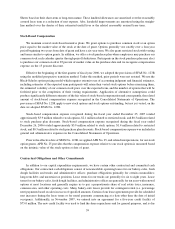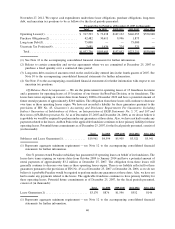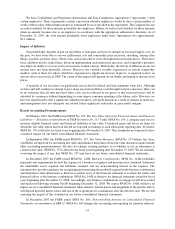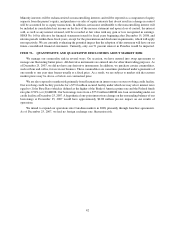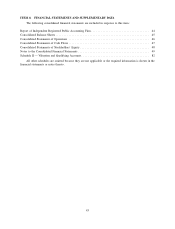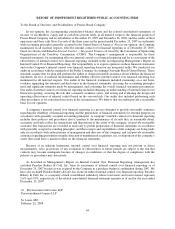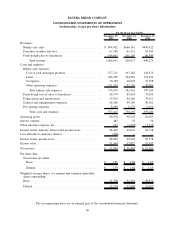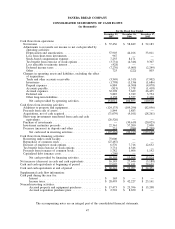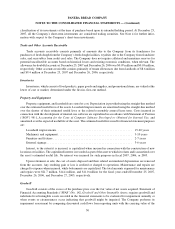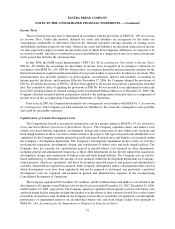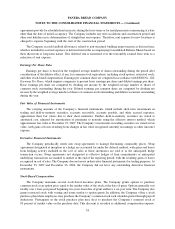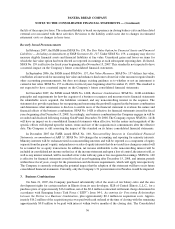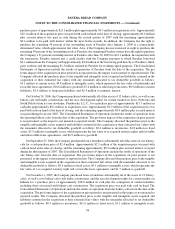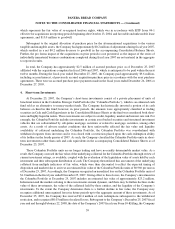Panera Bread 2007 Annual Report Download - page 59
Download and view the complete annual report
Please find page 59 of the 2007 Panera Bread annual report below. You can navigate through the pages in the report by either clicking on the pages listed below, or by using the keyword search tool below to find specific information within the annual report.PANERA BREAD COMPANY
NOTES TO THE CONSOLIDATED FINANCIAL STATEMENTS
1. Nature of Business
Panera Bread Company and its subsidiaries operate a retail bakery-cafe business and franchising business
under the concept names Panera Bread», Saint Louis Bread Co.», and Paradise Bakery & Café». As of December 25,
2007, the Company’s retail operations consisted of 532 Company-owned bakery-cafes. The Company specializes in
meeting consumer dining needs by providing high quality food, including some or all of the following: fresh baked
goods, made-to-order sandwiches on freshly baked breads, Crispani»hand-crafted pizza, soups, salads, and cafe
beverages, and targets suburban dwellers and workers by offering a premium specialty bakery and cafe experience
with a neighborhood emphasis. Bakery-cafes are principally located in suburban, strip mall, and regional mall
locations and currently operate in 40 states. Bakery-cafes use fresh dough for their artisan and sourdough breads and
bagels. As of December 25, 2007, the Company’s fresh dough operations, which supply fresh dough items daily to
most Company-owned and franchise-operated bakery-cafes, consisted of 20 Company-owned fresh dough
facilities.
2. Summary of Significant Accounting Policies
Basis of Presentation and Principles of Consolidation
The accompanying consolidated financial statements of Panera Bread Company and its subsidiaries (“the
Company”) consist of the accounts of Panera Bread Company and its wholly owned direct and indirect consolidated
subsidiaries. In addition, from and after February 1, 2007, the consolidated financial statements of Panera Bread
Company include its majority-owned consolidated subsidiary, Paradise Bakery & Café, Inc. (“Paradise”). All
intercompany balances and transactions have been eliminated in consolidation.
Fiscal Year
In fiscal year 2006, the Company adopted a 52/53 week fiscal year that ends on the last Tuesday in December
and included 52 weeks in 2007 and 2006. In 2005, the Company changed its fiscal week to end on Tuesday rather
than Saturday, with its fiscal year ending on the last Tuesday in December. As a result, the Company’s 2005 fiscal
year ended on December 27, 2005 and consisted of fifty-two and a half weeks rather than the fifty-three week year
that would have resulted without the calendar change. The additional days in fiscal 2005 occurred in the first
quarter, resulting in the first quarter being sixteen and a half weeks. The additional three days in the first quarter of
2005 did not have a material impact on the Company’s consolidated financial statements.
Use of Estimates
The preparation of financial statements in conformity with accounting principles generally accepted in the
United States of America requires management to make estimates and assumptions that affect the reported amounts
of assets and liabilities and disclosure of contingent assets and liabilities at the date of the financial statements and
the reported amounts of revenues and expenses during the reporting period. Actual results could differ from those
estimates.
Cash and Cash Equivalents
The Company considers all highly liquid investments with a maturity at the time of purchase of three months or
less to be cash equivalents.
Short-term Investments
The Company’s investments consist of trading securities that are stated at fair value, with gains or losses
resulting from changes in fair value recognized currently in earnings as other (income) expense, net and held-to-
maturity securities, that are stated at amortized cost, adjusted for amortization of premiums or discounts to maturity
using the effective interest method, which approximated fair value. Management designates the appropriate
49


